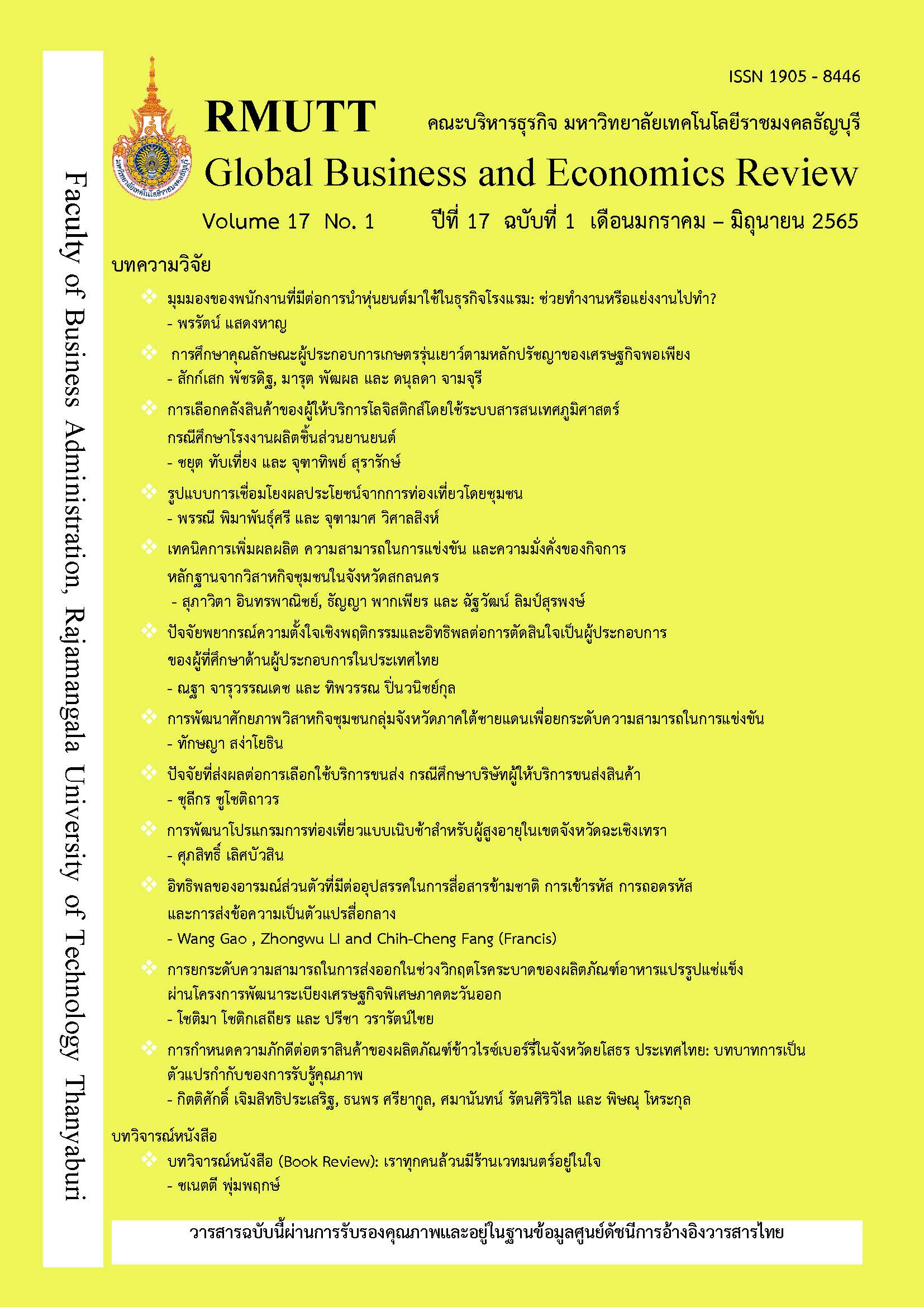ปัจจัยพยากรณ์ความตั้งใจเชิงพฤติกรรมและอิทธิพลต่อการตัดสินใจเป็นผู้ประกอบการของผู้ที่ศึกษาด้านผู้ประกอบการในประเทศไทย
คำสำคัญ:
การควบคุมพฤติกรรม, ผู้ประกอบการ, พฤติกรรมบทคัดย่อ
ความตั้งใจเชิงพฤติกรรมได้รับความสนใจว่าสามารถพยากรณ์การแสดงพฤติกรรมหรือการตัดสินใจเป็นผู้ประกอบการของบุคคลตามทฤษฎีพฤติกรรมตามแผน โดยมีปัจจัยด้านทัศนคติที่มีต่อพฤติกรรม บรรทัดฐานทางสังคม และการรับรู้ความสามารถในการควบคุมพฤติกรรม เป็นปัจจัยกำหนดความตั้งใจในการแสดงพฤติกรรม งานวิจัยนี้มีวัตถุประสงค์เพื่อทดสอบสมมติฐานโครงสร้างความสัมพันธ์ของปัจจัยกำหนดความตั้งใจในการแสดงพฤติกรรมมีผลต่อการตัดสินใจเป็นผู้ประกอบการของนักศึกษาและผู้สำเร็จการศึกษาระดับบัณฑิตศึกษาในสาขาผู้ประกอบการหรือไม่ โดยเก็บรวบรวมข้อมูลด้วยแบบสอบถามจากกลุ่มตัวอย่างจำนวน 400 คน และใช้วิธีการวิเคราะห์แบบจำลองสมการโครงสร้าง ผลการศึกษาพบว่าสมการโครงสร้างของข้อมูลเชิงประจักษ์สอดคล้องกับโครงสร้างความสัมพันธ์ตามทฤษฎีพฤติกรรมตามแผน โดยปัจจัยที่มีอิทธิพลทางตรงต่อความตั้งใจในการเป็นผู้ประกอบการ และมีอิทธิพลทางอ้อมต่อการตัดสินใจเป็นผู้ประกอบการผ่านความตั้งใจในการเป็นผู้ประกอบการของนักศึกษาและผู้สำเร็จการศึกษาระดับบัณฑิตศึกษาในสาขาผู้ประกอบการได้แก่ ทัศนคติที่มีต่อพฤติกรรม บรรทัดฐานทางสังคม และการรับรู้ความสามารถในการควบคุมพฤติกรรม การทดสอบสมมติฐานไม่ยืนยันว่าการรับรู้ความสามารถในการควบคุมพฤติกรรมมีอิทธิพลทางตรงต่อการแสดงพฤติกรรมการเป็นผู้ประกอบการ ผลการศึกษาสะท้อนว่าการศึกษาในหลักสูตรด้านผู้ประกอบการมีผลต่อการตัดสินใจเป็นผู้ประกอบการ สถาบันการศึกษาที่จัดหลักสูตรด้านผู้ประกอบการสามารถนำผลการศึกษาไปประยุกต์ใช้โดยอาจจัดให้มีสนามทดลองในการลงมือปฏิบัติเพื่อช่วยสร้างความมั่นใจและรับรู้ถึงความสามารถในการควบคุมพฤติกรรมการเป็นผู้ประกอบการ การสร้างบรรยากาศเรียนรู้ทำให้เกิดทัศนคติเชิงบวกต่อการเป็นผู้ประกอบการ เพื่อช่วยผลักดันการแสดงพฤติกรรมการเป็นผู้ประกอบการ
References
คมกริช นันทะโรจพงศ์, ภูธิป มีถาวรกุล และประสพชัย พสุนนท์. (2561). พฤติกรรมการเป็นผู้ประกอบการของวัยรุ่นไทย: อิทธิพลของการรับรู้ ความสามารถตนเองและการรับรู้การสนับสนุนทางสังคมต่อความตั้งใจ ในการเป็นผู้ประกอบการในบริบทวัฒนธรรมแบบรวมกลุ่ม. วารสารบริหารธุรกิจศรีนครินทรวิโรฒ, 9(2), 244–59.
มารยาท โยทองยศ และทรงวาด สุขเมืองมา. (2559). ปัจจัยที่มีอิทธิพลต่อความตั้งใจที่จะเป็นผู้ประกอบการของนักศึกษาปริญญาตรี: กรณีศึกษามหาวิทยาลัยกรุงเทพ. วารสารสุทธิปริทัศน์, 30(95), 103-115.
Ajzen, I. (1991). The Theory of Planned Behavior. Organizational Behavior and Human Decision Processes, 50(2), 179–211.
Ajzen, I. (2002). Perceived behavioral control, self-efficacy, locus of control, and the theory of planned behavior. Journal of Applied Social Psychology, 32(4), 665–683.
Ambad, S. N. A., & Damid, H. D. A. (2016). Determinants of Entrepreneurial Intention Among Undergraduate Students in Malaysia. Procedia Economics and Finance, 37, 108-114.
Barbera, F. L., & Ajzen, I. (2020). Control Interactions in the Theory of Planned Behavior: Rethinking the Role of Subjective Norm. Europe's Journal of Psychology, 16(3), 401-417.
Baron, R. A. (2004). The cognitive perspective: a valuable tool for answering entrepreneurship’s basic “why” questions. Journal of Business Venturing, 19(2), 221–239.
Bentler, P. M., & Chou, C. (1987). Practical issues in structural modeling. Sociological Methods and Research, 16(1), 78–117.
Bollen, K. A. (1989). Structural equations with latent variables. New York: Wiley.
Cronbach, L. J. (1990). Essentials of Psychological Testing (5th ed). New York: Harper Collins Publishers.
Ding, L., Velicer, W. F., & Harlow, L. L. (1995). Effects of estimation methods, number of indicators per factor, and improper solutions in structural equation modeling fit indices. Structural Equation Modeling, 2(2), 119–144.
Farrukh, M., Alzubi, Y., Shahzad, I. A., Waheed, A., & Kanwal, N. (2018). Entrepreneurial Intentions: The Role of Personality Traits in Perspective of Theory of Planned Behavior. Asia Pacific Journal of Innovation and Entrepreneurship, 12(3), 399–414.
Ferreira, J. J., Raposo, M. L., Rodrigues, R. G., Dinis, A., & Paço, A. D. (2012). A Model of Entrepreneurial Intention: An Application of the Psychological and Behavioral Approaches. Journal of Small Business and Enterprise Development, 19(3), 424–440.
Fishbein, M., & Ajzen, I. (1975). Belief, attitude, intentions and behavior: An introduction to theory and research. Boston: Addison-Wesley.
Fornell, C., & Larcker, D. F. (1981). Evaluating Structural Equation Models with Unobservable Variables and Measurement Error. Journal of Marketing Research, 18(1), 39-50.
Foster, J. J., Brakus, E., & Yavorsky, C. (2006). Understanding and Using Advanced Statistics. London: SAGE Publication.
Hair, J. F., Anderson, R., Tatham, R., & Black, W. (1998). Multivariate data analysis (5th ed). New Jersey: Prentice-Hall.
Hair, J. F., Black, W.C., Babin, B.J., & Anderson, R.E. (2014). Multivariate data analysis (7th ed). Essex, UK, Pearson Education Limited.
Hooper, D., Coughlan, J., & Mullen, M. R. (2008). Structural Equation Modelling: Guidelines for Determining Model Fit. Electronic Journal of Business Research Methods, 6(1), 53-60.
Hou, F., Yu, S., Lu, M., & Qi, M. (2019). Model of the Entrepreneurial Intention of University Students in the Pearl River Delta of China. Frontiers in Psychology, 10, 1-16.
Kaiser, H. F. (1970). A Second-Generation Little Jiffy. Psychometrika, 35(4), 401-415.
Kaiser, H. F., & Rice, J. (1974). Little jiffy: Mark IV. Educational and Psychological Measurement, 34(1), 111-117.
Kautonen, T., Gelderen, M. V., & Tornikoski, E. (2013). Predicting Entrepreneurial Behaviour: A Test of the Theory of Planned Behavior. Applied Economics, 45(6), 697–707.
Kautonen, T., Gelderen, M. V., & Fink, M. (2015). Robustness of the Theory of Planned Behavior in Predicting Entrepreneurial Intentions and Actions. Entrepreneurship Theory and Practice, 39(3), 655–674.
Krueger, N. F., & Brazeal, D. V. (1994). Entrepreneurial potential and potential entrepreneurs. Entrepreneurship Theory and Practice, 18(3), 91–104.
Liñán, F., & Rodríguez-Cohard, J. C. (2015). Assessing the Stability of Graduates’ Entrepreneurial Intention and Exploring Its Predictive Capacity. Academia Revista Latinoamericana de Administracion, 28(1), 77–98.
Misoska, A. T., Dimitrova, M., & Mrsik, J. (2016). Drivers of Entrepreneurial Intentions among Business Students in Macedonia. Economic Research-Ekonomska Istrazivanja, 29(1), 1062–1074.
Nergui, E. (2020). The Translation of Entrepreneurial Intention into Behavior. Hokkaido University Collection of Scholarly and Academic Papers, 70(2), 125-137.
Rudhumbu, N., Svotwa, D., Munyanyiwa, T., & Mutsau, M. (2016). Attitudes of Students towards Entrepreneurship Education at Two Selected Higher Education Institutions in Botswana: A Critical Analysis and Reflection. Academic Journal of Interdisciplinary Studies MCSER Publishing, 5(2), 83-94.
Shane, S., & Venkataraman, S. (2000). The promise of entrepreneurship as a field of research. Academy of Management Review, 25(1), 217–226.
Schlaegel, C., & Koenig, M. (2012). Determinants of entrepreneurial intent: A meta-analytic test and integration of competing models. Journal of Entrepreneurship Theory and Practice, 38(2), 291-332.
Schumacker, R. E. & Lomax, R. G., (2010). A beginner’s guide to structural equation modeling. (3rd ed.). New Jersey: Lawrence Erlbaum Associates.
Tanaka, J. S. (1987). “How big is big enough?”: Sample Size and Goodness of Fit in Structural Equation Models with Latent Variables. Child Development, 58(1), 134– 146.
Tassawa, C. (2019). A Structural Model for Predicting Entrepreneurial Intention of University Students. Humanities, Arts and Social Sciences Studies, 19(2), 362–386.
Turulja, L., Veselinovic, L., Agic. E., & Pasic-Mesihovic, A. (2020). Entrepreneurial Intention of Students in Bosnia and Herzegovina: what Type of Support Matters. Economic Research-Ekonomska Istrazivanja, 33(1), 2713–2732.
Vries de, H., Dijkstra, M., & Kuhlman, P. (1988). Self-efficacy: The Third Factor Besides Attitude and Subjective Norm as a Predictor of Behavioural Intentions. Health Education Research, 3(3), 273-282.
Downloads
เผยแพร่แล้ว
How to Cite
ฉบับ
บท
License
Copyright (c) 2022 ณฐา จารุวรรณเดช, ทิพวรรณ ปิ่นวนิชย์กุล

This work is licensed under a Creative Commons Attribution-NonCommercial-NoDerivatives 4.0 International License.
บทความที่ได้รับการตีพิมพ์เป็นลิขสิทธิ์ของผู้นิพนธ์
ข้อความที่ปรากฏในบทความแต่ละเรื่องในวารสารวิชาการเล่มนี้เป็นความคิดเห็นส่วนตัวของผู้เขียนแต่ละท่านไม่เกี่ยวข้องกับมหาวิทยาลัยเทคโนโลยีราชมงคลธัญบุรี และคณาจารย์ท่านอื่นๆในมหาวิทยาลัยฯ แต่อย่างใด ความรับผิดชอบองค์ประกอบทั้งหมดของบทความแต่ละเรื่องเป็นของผู้เขียนแต่ละท่าน หากมีความผิดพลาดใดๆ ผู้เขียนแต่ละท่านจะรับผิดชอบบทความของตนเองแต่ผู้เดียว







